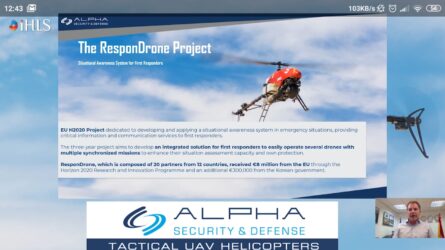ResponDrone concluding conference highlights the project’s key achievements and advantages as a leading emergency management system
June 14, 2022
The ResponDrone project concluding conference, held in Porto (Portugal) April 26-28, 2022, and hosted by INESC TEC, the project partner in Portugal, was attended by over 30 representatives from the 20-strong consortium’s partner organizations.
The conference served to both sum up the project’s achievements to date and look ahead to the future. Perhaps, the most important takeaway from the conference is the fact that all end users related to the project’s main advantages based on the use of drones in disaster management as being their low-cost, small size and manoeuvrability.
Project milestones
DLR provided an overview of the key project milestones over the course of the last year. During this time the consortium pursued, often in extremely adverse conditions, a coherent set of activities for finalizing, testing, demonstrating, training, disseminating and product development.
The key steps completed included:
- Completion of component development and integration
- Development of the training platform
- The challenging first dry run in Atlas in September 2021, followed by the final demonstration held again in Atlas in March 2022. To share the full results of the final demonstration, some very high quality videos were shared with the consortium, showing the potential of the platform
- The training exercise (Corte, Corsica, February 2022), coordinated by HCFDC and supported by SDIS, focusing on the involvement of end users

ResponDrone impact on end-user operations
AUA provided a focused and insightful summary of the project’s impact on the practical implications for end users and the impact ResponDrone has had on first responder (FR) operations, stimulating further integration and use of drones in disaster response missions.
Key takeaways on end-user insights:
- The end users using drones in first response operations reported the use of drones as very effective and useful.
- The ability of a single pilot to operate a fleet of drones is an outstanding advantage.
- All end users reported the following advantages in using drones during the different stages of emergency management: low-cost, small size and manoeuvrability.
- The top 3 important drone missions in the first response operations were reported as: early detection, prevention and real-time monitoring.
Key examples of the project’s impact on end-user operations:
- MES has added 10 drones and is currently training pilots;
- RCM has just started by adding 2 drones for tactical use;
- VRH added an extra team and is integrating it into the actual operations of 6 operational teams across the country. An additional reconnaissance unit has been formed and there is on average 2 drone flights per day across the Netherlands.
- HCFDC noted that French firefighters use drones, though the situation varies from region to region. Despite new legal issues emerging with the use of drones by the police to monitor compliance with COVID-19 related rules, a new regulatory framework is expected to make these new missions possible.
- In Latvia, ResponDrone helped SFRS to better understand how and at which levels (tactical, operational and strategic) drones can be used. There are now 60+ drones over the first two levels while the strategic level, as the scale is much larger, requires partners such as the border guard and the state police as well as procedures for no flight zones etc; on the tactical level, each fire truck is required to have at least one pilot licensed to command a drone, as they are used to find the fire and water and roads to the incident. Advantages include their capacity to fly at night using spotlights. SFRS stated that the use of drones to date has been a key factor in saving at least 3 lives.
The ResponDrone partners also related to the various planned uses of the system, as seen in the image below:

Commercialization
ResponDrone partner organization, IAI, highlighted the fact that the project’s approach dovetails well with the tendency of large industrial players (such as IAI) to offer a One-Stop Shop for UAS, including for first responders. In this regard, the results of the market research conducted by ResponDrone were borne out by similar, larger-scale research conducted by IAI.
Moreover, ResponDrone has proven to be a particularly instructive experience for industrial partners, as the large-scale demo and the constant interaction with end-users provided invaluable lessons for the development of an MVP (minimum viable product). Such an MVP, expected to be ready by the end of 2022, will deliver an integrated solution to leverage the assets of end-users, safely connecting with their IT and communication systems, while remaining open to enlarge its scope to cover activities such as environmental monitoring.
Future challenges
Looking to the future, the conference also highlighted the various challenges for the use of drones by the end users. Among the key challenges mentioned were pilot training, information accessibility, changing decision-making patterns, while one clear challenge common to all end users is the regulation on the use of airspace that is compatible with existing regulations for manned aviation.




